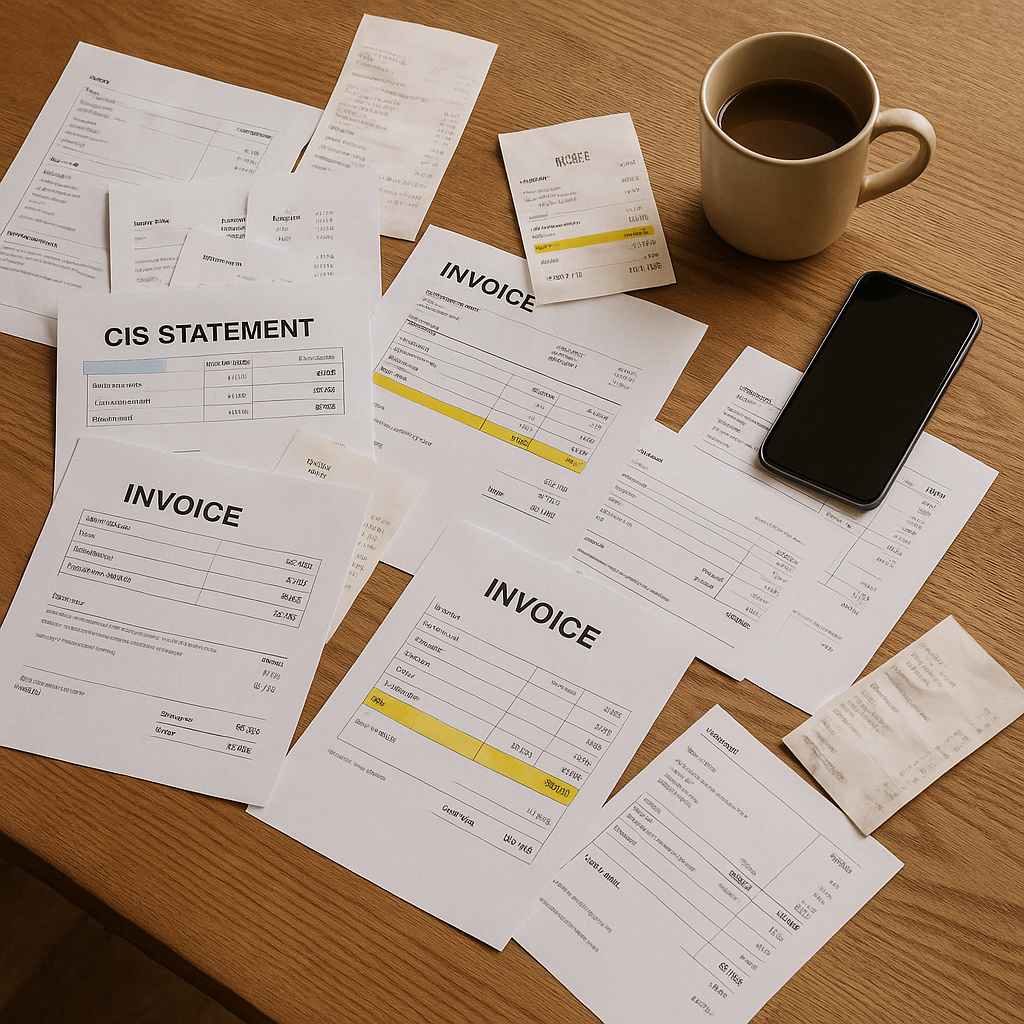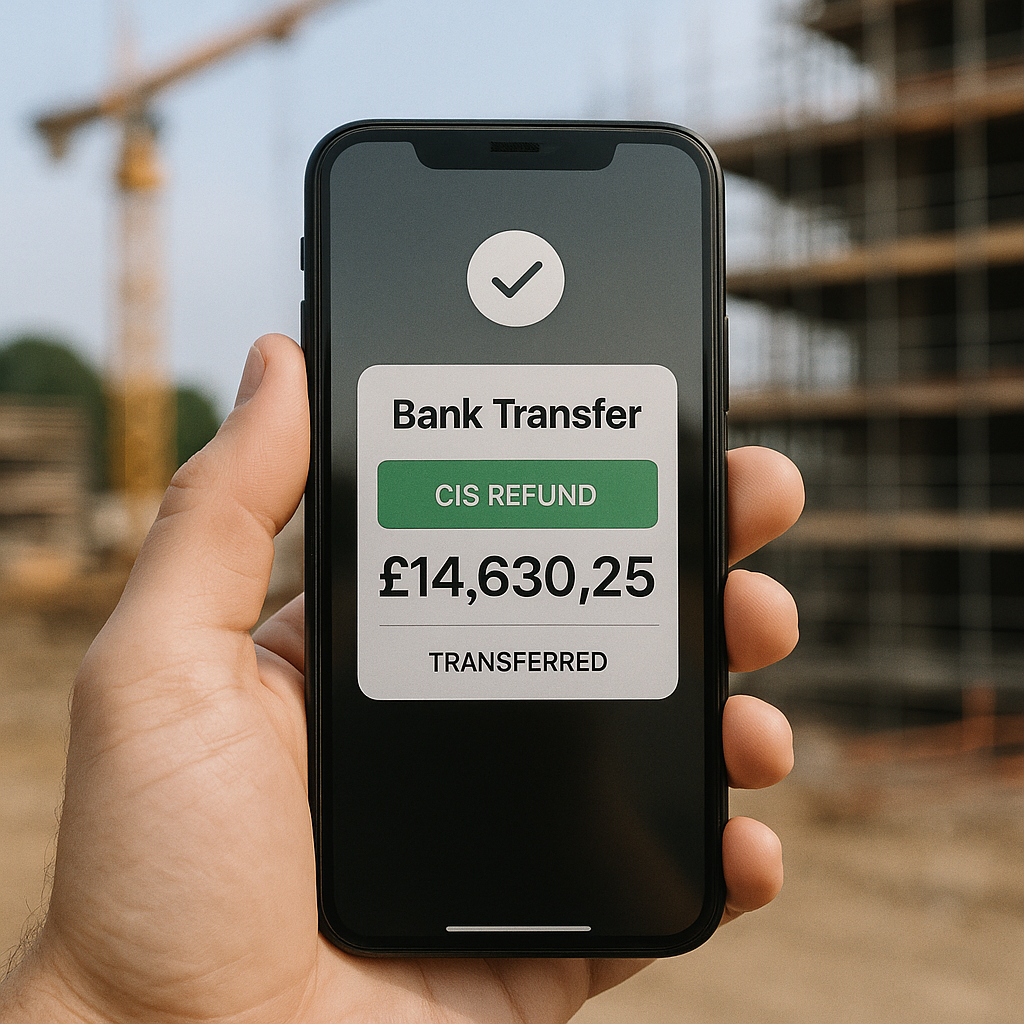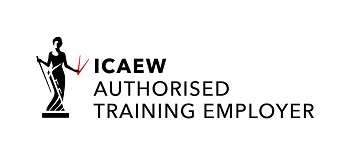
Ever wonder why construction workers seem to have a perpetual frown when tax season rolls around? It’s not just the paperwork – it’s the sneaking suspicion that HMRC might owe them money. And here’s the kicker: they’re often right.
The Construction Industry Scheme (CIS) operates like a peculiar game of financial musical chairs. Contractors deduct money from subcontractors’ payments, send it to HMRC, and sometimes – quite often, actually – too much gets taken. The result? Thousands of construction professionals are sitting on unclaimed CIS repayment claim without even realising it.
If you’re a subcontractor who’s been paying into the system, this might be the most profitable ten minutes you’ll spend reading this year. Because recovering those overpaid deductions isn’t just possible – it’s surprisingly straightforward once you know the ropes.
The Hidden World of CIS Overpayments
Picture this: You’re a plasterer working on three different sites. Contractor A deducts 20% from your invoice because you don’t have gross payment status. Contractor B does the same. So does Contractor C. By year’s end, you’ve had £8,000 deducted from your earnings and sent to HMRC.
Come tax return time, your actual tax bill? £4,500.
That £3,500 difference isn’t lost in the ether – it’s your money, and HMRC will gladly return it. They just won’t chase you down to tell you about it.
This scenario plays out thousands of times annually across Britain’s construction sites. Roofers, electricians, decorators, and countless other trades are unwittingly funding the Treasury’s coffee budget while their own bank accounts remain lighter than necessary.

Why CIS Overpayments Happen (And Why They’re More Common Than You Think)
The construction industry’s unique payment structure creates perfect conditions for overpayments. Subcontractors face either 20% or 30% deductions, as detailed in the official Construction Industry Scheme [CIS] Full Guide 2024, depending on their CIS registration status. But your actual tax liability? That’s calculated on your total annual income, allowances, and circumstances.
The mathematics rarely align perfectly.
Consider these common scenarios where CIS repayment claims become inevitable:
- Seasonal work patterns: Busy summer months with high deductions, quieter winter periods with lower overall income
- Multiple income streams: CIS work combined with PAYE employment or other self-employed income
- Business expenses: Significant tool purchases, vehicle costs, or training that reduce taxable profit
- Personal circumstances: Changes in family situation affecting tax-free allowances
These deductions count towards the subcontractors’ tax and National Insurance, spreading the payments out over time instead of one lump sum at the end of the tax year. You can learn more about what the Construction Industry Scheme (CIS) is and how it works to understand the fundamentals. Most subcontractors operate under the 20% deduction rate, but their effective tax rate often sits well below this threshold. The difference accumulates throughout the year, creating substantial CIS repayment claim opportunities.
The Anatomy of a CIS Repayment Claim
Before diving into the claiming process, it’s worth understanding what you’re actually claiming. A CIS repayment claim isn’t about gaming the system – it’s about recovering your own money that was deducted as an advance payment towards your tax bill.
Think of it like this: if you accidentally paid £50 for a £30 meal, you’d expect £20 change. CIS refunds operate on the same principle, just with more paperwork.
What qualifies for a CIS repayment claim:
- Excess deductions above your actual tax liability
- Overpayments from previous tax years (you can claim back up to four years)
- Deductions made when you had no tax liability due to low income or high expenses
What doesn’t qualify:
- Routine business expenses (these reduce your taxable profit but aren’t direct refunds)
- Deductions properly applied to your tax bill
- Payments made outside the CIS scheme
Essential Documentation: Your Paper Trail to Success
Here’s where things get interesting – and slightly tedious. HMRC loves documentation, and CIS repayment claims require meticulous record-keeping. But here’s the silver lining: if you’re organised, this process becomes remarkably straightforward. A good bookkeeping service can be invaluable here.
Primary documents you’ll need:
| Document Type | Purpose | Where to Find It |
| CIS Deduction Statements | Proof of deductions made | Monthly statements from contractors |
| Payment/Remittance Advice | Verification of gross payments | Invoice records, payment receipts |
| Bank Statements | Income verification | Your business bank account |
| Expense Records | Reducing taxable profit | Receipts, invoices, purchase records |
| Previous Tax Returns | Historical context | Your records or HMRC |
The devil’s in the details here. Missing even one month’s CIS statement can delay your CIS repayment claim by weeks. I’ve seen perfectly valid claims stall because someone couldn’t locate a single piece of paper worth £47.
Your CIS deduction statements should arrive monthly from each contractor. They’re small, easy to lose, and absolutely crucial. File them immediately – preferably in a dedicated folder that you’ll remember exists in eleven months’ time.

Step-by-Step: Making Your CIS Repayment Claim
Right, let’s get practical. The actual claiming process involves several stages, each with its own potential pitfalls and shortcuts.
Stage 1: Gather Your Arsenal
Before even thinking about forms, collect every CIS-related document from the tax year in question. This includes:
- All monthly CIS deduction statements
- Invoices sent to contractors
- Records of payments received
- Business expense receipts
- Any correspondence with HMRC about your CIS status
Spread everything across a table (or several tables – construction paperwork expands to fill available space). Organise by contractor, then by month. This archaeological exercise often reveals forgotten deductions or missing statements.
Stage 2: Calculate Your Position
This is where basic arithmetic becomes surprisingly complex. You need to establish:
- Total CIS deductions for the year: Add up all deductions shown on your monthly statements. Don’t rely on memory – contractors sometimes make errors, and you need the exact figures.
- Actual tax liability: Calculate your true tax bill based on total income, allowable expenses, and personal circumstances. This determines whether you’ve overpaid.
- Potential refund amount: The difference between deductions and actual liability becomes your potential CIS repayment claim amount.
Stage 3: Choose Your Claiming Method
For individual subcontractors, CIS repayment claims can be made using form CIS40 either online or by post. You can find information from services like CloudCo Accountants or RIFT Tax Refunds. However, the best route depends on your circumstances:
- The Self Assessment route: Complete your tax return as normal, including all CIS deductions in the appropriate sections. HMRC’s system will automatically calculate any refund due and either offset it against other tax owed or arrange repayment. We can help you file your Self Assessment with ease.
- The CIS40 route: This standalone form allows you to claim a refund during the current tax year, but only applies where your work in the construction industry has ceased, and all tax affairs are up to date. You can find more information on how to claim a CIS tax refund. You can use the online form service or fill in the form on-screen, print it off, and post it to HMRC. The online service provides a reference number to track progress. More details are available on the CIS40 Individual’s repayment claim.
For Limited Companies: Limited companies reclaim CIS deductions through their PAYE system. Each month, you submit a Full Payment Submission (FPS) and an Employer Payment Summary (EPS) to HMRC, reporting CIS deductions. These deductions are offset against your company’s PAYE and National Insurance liabilities. Our payroll management service can handle this for you.
Stage 4: Submit and Wait
You can claim back your CIS repayment after 5 April when the tax year ends. Claims must be submitted within four years from the end of the relevant tax year regardless of whether the claimant is still working in construction, as explained in this guide on CIS Repayment for Limited Companies and Sole Traders.
Once submitted, HMRC typically processes CIS repayment claims within 6-8 weeks. However, complex cases or incomplete documentation can extend this significantly.
Pro tip: Submit claims early in the tax year when HMRC’s workload is lighter. April submissions often process faster than January ones.
Common Pitfalls and How to Avoid Them
Years of dealing with CIS repayment claims have revealed predictable patterns in what goes wrong. Here are the most common mistakes – and how to sidestep them entirely.
- The “I’ll remember” fallacy: Construction workers are optimists. They believe they’ll remember every deduction, every payment, every contractor. They won’t. Keep contemporaneous records or accept that you’ll lose money.
- Mixing CIS and non-CIS income: If you have both CIS and non-CIS income, ensure you’re claiming the right deductions against the right income streams. HMRC’s computers are surprisingly good at spotting inconsistencies.
- Ignoring the four-year rule: You can claim CIS refunds for up to four years after the end of the relevant tax year. This guide on CIS Repayment for Limited Companies and Sole Traders reiterates this point. Many subcontractors only focus on the current year, missing potentially substantial historic refunds.
- Inadequate expense records: Business expenses reduce your taxable profit, potentially increasing your CIS repayment claim. But HMRC won’t accept “I spent loads on tools” as documentation. Keep receipts, record mileage, document everything.
- Filing too early: If you submit your return before the filing deadline of 5 April, your records may not show all deductions for the previous tax year. This may cause delays or an incorrect payment. Official guidance is available on how to claim a refund of Construction Industry Scheme deductions if you’re a limited company or an agent.
When Professional Help Makes Sense
There’s a curious psychology around CIS repayment claims. Simple cases feel complicated, while genuinely complex situations appear deceptively straightforward. Knowing when to seek professional help can save time, money, and considerable frustration.
DIY-friendly scenarios:
- Single contractor relationships
- Straightforward income patterns
- Good record-keeping habits
- Previous experience with Self Assessment
Professional help recommended:
- Multiple contractors across different tax years
- Mixed CIS and PAYE income
- Significant business expenses or equipment purchases
- Historic claims requiring detailed reconstruction
Complex situations requiring expertise:
- Disputes over CIS status or deduction rates
- Missing documentation requiring reconstruction
- Appeals against HMRC decisions or HMRC investigations
- Corporate structure changes affecting CIS treatment
Firms like Ask Accountant specialise in navigating these complexities, offering comprehensive tax advisory solutions and CIS claims expertise. Their location at 178 Merton High St, London SW19 1AY puts them at the heart of London’s construction industry, and their experience with CIS repayment claims often reveals refund opportunities that individuals might miss.
The Technology Factor: Digital Tools and Online Claims
HMRC’s digital transformation has revolutionised CIS repayment claims – mostly for the better. The online portal offers real-time processing, instant acknowledgements, and direct bank transfers for refunds. Using cloud accounting software can further streamline this process.
Advantages of digital submission:
- Faster processing times
- Immediate confirmation of receipt
- Built-in error checking
- Direct bank transfer for refunds
- Reference numbers for tracking progress
Potential challenges:
- Technical glitches during peak periods
- Learning curve for less tech-savvy users
- Limited human support when things go wrong
The system works well for straightforward CIS repayment claims but can become frustrating when dealing with complex scenarios or missing documentation.
Timing Your CIS Repayment Claim
When you submit your CIS repayment claim matters more than most people realise. HMRC’s processing capacity varies dramatically throughout the year, and understanding these patterns can significantly impact your experience.
Optimal timing:
- April-June: Light workload, faster processing
- July-September: Moderate capacity, reasonable turnaround
- October-December: Increasing pressure, slower responses
- January-March: Peak season, longest delays
If you’re not bound by Self Assessment deadlines, consider timing your CIS repayment claim to avoid HMRC’s busiest periods.
Understanding HMRC’s Review Process
Once submitted, your CIS repayment claim enters HMRC’s review process. Understanding this process helps set realistic expectations and identify potential issues early.
- Initial review (1-2 weeks): HMRC’s systems perform automated checks for obvious errors, missing information, or inconsistencies. Simple claims often receive approval at this stage.
- Detailed assessment (2-6 weeks): More complex claims undergo human review. HMRC may request additional documentation or clarification during this phase.
- Final processing (1-2 weeks): Approved claims are processed for payment, with funds typically transferred within 10 working days.
Red flags that trigger extended review:
- Large refund amounts relative to income
- Inconsistent information across tax years
- Missing or incomplete documentation
- Previous disputes with HMRC
Beyond the Basics: Advanced CIS Strategies
Repayment of CIS to subcontractors of an experienced company may become one of the elements of a broader tax optimization scheme. They are sophisticated methods that need planning and may give great results with the right business advice.
- Quarterly review: As opposed to annual claims, review your CIS position every quarter. This approach identifies overpayments early and allows for more strategic planning around your CIS repayment claim timing.
- Gross payment status: Achieving gross payment status eliminates CIS deductions entirely. The application process is demanding, but the cash flow benefits can be transformative for established subcontractors.
- Corporate structure issues: Trading in the form of a limited company can alter your CIS treatment. This strategy requires careful corporate tax planning but can be of great benefit to larger-profit subcontractors.
Real-World Success Stories
The abstract nature of tax refunds can make CIS repayment claims feel theoretical. These are a few practical cases in point:
- The Seasonal Roofer: A roofer who earns a lot of money in the summer, and very little in the winter had £12,000 removed in the summer months. His actual tax bill? £6,500. Annual CIS repayment claim: £5,500.
- The Multi-Trade Contractor: An electrician working for three different contractors discovered historic overpayments spanning three years. Total CIS repayment claim: £18,000.
- The Equipment Investor: A decorator who purchased a new van and equipment found that legitimate business expenses reduced his taxable profit significantly. CIS refund: £3,200.
These aren’t exceptional cases – they’re typical examples of what happens when subcontractors actively manage their CIS position and pursue their CIS repayment claims.
Future-Proofing Your CIS Strategy
The construction industry continues evolving, and CIS regulations evolve with it. Staying ahead of these changes can prevent future overpayments and maximise CIS repayment claim opportunities.
Recent developments:
- Enhanced digital reporting requirements
- Stricter verification procedures
- Improved fraud detection systems
- Streamlined gross payment applications
Emerging trends:
- Increased focus on off-payroll working rules (IR35)
- Enhanced scrutiny of corporate structures
- Greater emphasis on real-time reporting
- Improved integration with other tax systems
The Bottom Line: Your Money, Your Choice
CIS repayment claims aren’t about finding loopholes or gaming the system – they’re about recovering money that legitimately belongs to you. The construction industry’s unique payment structure creates systematic overpayments, and HMRC expects you to claim them back.
The choice is stark: remain passive and fund the Treasury’s operations with your overpayments, or take action and recover what’s rightfully yours. For most subcontractors, the decision should be obvious.
Start by gathering your documentation, calculate your position, and submit your CIS repayment claim. The process might feel daunting initially, but the financial rewards often justify the effort many times over.
Remember: every month you delay is money remaining in HMRC’s hands instead of yours. And unlike the construction industry, the government doesn’t pay interest on delayed payments.
Your CIS repayment claim starts today – because your money has been waiting long enough. Contact us to get started.

Frequently Asked Questions
How far back can I claim CIS refunds?
You can claim CIS refunds for up to four years after the end of the relevant tax year. This is confirmed in multiple guides, including this one on CIS Repayment for Limited Companies and Sole Traders. This means substantial historic refunds are often available through your CIS repayment claim.
What if I can’t find all my CIS deduction statements?
Contact your contractors directly – they’re required to provide copies. HMRC may also have records, though obtaining them can be time-consuming.
Can I claim CIS refunds if I’m also employed elsewhere?
Yes, but the calculation becomes more complex. You’ll need to consider your total income from all sources when determining your actual tax liability for your CIS repayment claim. Our personal tax planning service can help.
How long does HMRC take to process CIS repayment claims?
Typical processing time is 6-8 weeks, though complex cases can take longer. Submit early in the tax year for faster processing.
What happens if HMRC rejects my CIS repayment claim?
You can appeal the decision within 30 days. Most rejections result from incomplete documentation rather than invalid claims. We can assist with HMRC investigations and appeals.
When can I make a CIS repayment claim during the tax year?
You can get a refund in the year via the completion of form CIS40, but this only applies where your work in the construction industry has ceased, and all tax affairs are up to date, as explained in this guide on How to Claim a CIS Tax Refund.
What’s the difference between CIS40 and claiming through Self Assessment?
CIS40 is for mid-year claims when you’ve stopped construction work, while Self Assessment is the standard annual method for ongoing subcontractors to make their CIS repayment claim.







